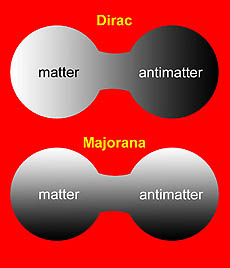Neutrinos: Majorana or Dirac?
 |
| If neutrinos are Dirac particles, their matter and antimatter versions are very different. If they are instead Majorana particles, the matter and antimatter components are the same thing. |
Read the expanded column on Majorana and Dirac neutrinos.
The neutrino is one of the most mysterious particles in the Standard Model.
Nearly massless, these subatomic ghosts can penetrate anything. If you filled space from here to the nearest star (about five light-years) with solid lead, you’d stop about half the Sun’s neutrinos. Neutrinos really don’t interact much.
Neutrinos have additional mysteries. For instance, the three types of neutrinos – electron, muon and tau – can morph into one another, converting back and forth as they travel. We call this behavior neutrino oscillation.
While neutrinos are a fascinating laboratory with which to study the fundamental laws of nature, there is a seemingly simple question about neutrinos that has not yet been answered. This question is, “Are neutrinos and antimatter neutrinos different particles or the same particle masquerading as two?” In a different Nutshell, we described matter and antimatter. Antimatter is the opposite of matter and will annihilate with matter to create energy. Thus it seems rather odd to ask if neutrinos and antineutrinos are the same particle.
In 1957, physicists showed that neutrinos and antineutrinos were different. The difference lies in their subatomic spin. You can, with some poetic license, treat subatomic particles as little spinning balls. In the microrealm, the axis around which the ball spins points in the direction of motion of the particle. Neutrinos have “left-handed” spin and antineutrinos have “right-handed” spin. This seems to clearly indicate that neutrinos and antineutrinos are different. However, if neutrinos have mass, it is always possible to change your frame of reference so that your direction of motion is reversed.
To understand this, imagine walking along a street in a northerly direction. As you walk, your position becomes “more north” with each step, compared to a streetlamp you pass. However, if a car heading north drives past you, a person in the car will see every second that you are further south from them as they travel. Thus a person standing near the lamppost and a person in the car will disagree as to your direction of motion. These two people would also therefore disagree on a neutrino’s handedness.
If neutrinos have mass (and we know they do, as we have observed neutrino oscillation), one can ask whether a neutrino and antineutrino are one and the same particle. If the two are different, they are called a Dirac particle (after Paul Dirac), while if the same, they are called a Majorana particle (after Ettore Majorana).
If neutrinos are Majorana particles, this opens up all sorts of new kinds of physics and could explain the very light mass of the neutrino.
—Don Lincoln
Want a phrase defined? Have a question? E-mail today@fnal.gov.
|